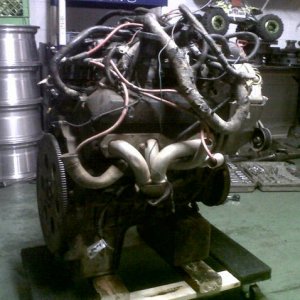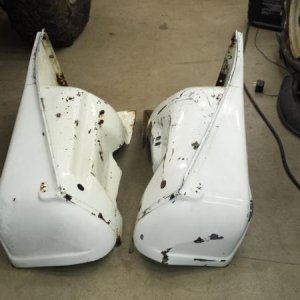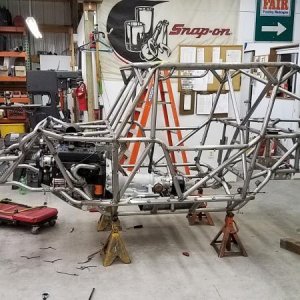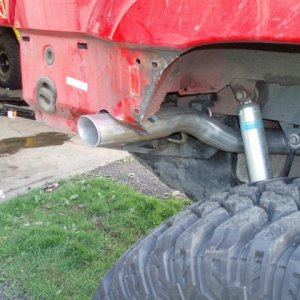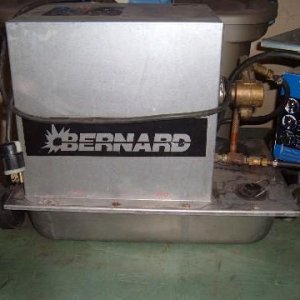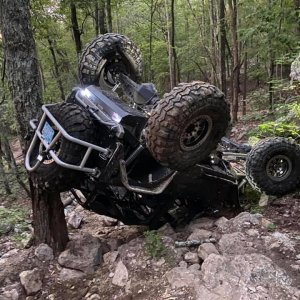Winching tech
Hi guys !
After seing a few of winch recoveries in the US (Pro Rockbouncing event, AOP 4cyl bash, …) and talking with Key at the Hardline Ride, I just wanted to share with you some of the winch tech I know.
I'm not trying to say I know everything about winching (far from it), but what I know might benefit some of you guys in the process of making your recoveries better and safer (main concern here). It's also fun to share info and to see what's happening in other parts of the world and I look forward to hear your feedback.
Being from EU, we have a bunch of competitions that include winching as a part of what you need to do to win. In Winch challenges, the « no ball, hit it with more speed » method doesn't work. The goal is to keep the vehicle intact for a full weekend of competition (including one or two night stages) so we're talking about a total of around 20/25h of driving and every break can DNF you if you're not able to fix your ride with the parts you brought with you and during the time limit. We're obviously trying to be as efficient as possible with winching to keep on driving (cause it's faster…) but you can't avoid it. It also allows to engage in obstacles that are completely unpassable with regular tire traction.
I have been part of a team that used to compete in some french events, just for fun. My job as a co driver was to be the dude that hooks up the winch to whatever is going to be a suitable anchor point to keep our car moving forward or rubber side down. And that's bout it. Some comps hosted in the eastern EU part last for a complete week and the co-dogs have to navigate the car too, but I have no experience in such events. Just a bunch of buddies stories. And they're nasty I've never been part of the « big dogs » who are driving all over EU to compete in the European championship, but I've got a few podium finishes under my belt so I feel pretty confident giving the opinions and advices that are presented here.
I've never been part of the « big dogs » who are driving all over EU to compete in the European championship, but I've got a few podium finishes under my belt so I feel pretty confident giving the opinions and advices that are presented here.
This is a video of a winch challenge I competed in. I'm part of the « Team Pirates » and you can see us at 6.45.
challenge xtremland sport 2011 ch2
This is the winching speed that I'm familiar with :
Gigglepin racing at the French Xtrem 2015
Red winch heavy pull.
And unloaded, WATCH YOUR HANDS !
Red Winch Hornet - 24V Supply on 12v Bow2 with Overdrive Gearset
AND USE GLOVES AT ALL TIMES !
First the cars :
In competition winching having two winches on your vehicle is mandatory. The reason is simple, if you have a catastrophic winch failure, you're still able to winch yourself out of the stage, one way or another. The two main winches are generally installed at the front and rear of the vehicle or front and mid-mounted. Some vehicles have three winches, installed like so : front, mid mounted and rear. The mid mounted winch cable exits through the roof with a donut fairlead and is used to stabilize the vehicle in off camber situations, to shift the body weight to help with traction and sometimes, to recover the car from a flop or rollover as help if forbidden in the competition and getting help will DNF you for the stage.
It looks like that :


You generally have 2 classes (varies with sanctioning bodies but that's the common way) which are modified and unlimited.
Modified is :
35" tires or less (measured during tech inspection, what's written on the side of the tire doesn't count)
Mechanical steering (Hydrau assist ok)
Based on a stock vehicle frame (at least 3/4 of the stock frame rails intact)
Unlimited is… well… unlimited.
Depending on the series you can have some that are allowing a full tube chassis in modified class and some that are forbidding rear steer in unlimited.
The good example of a Modified vehicle is the Nissan Patrol I used to co-dog :

Stock drivetrain
RCV shafts
ARB lockers ft/rr
Upgraded winches ft/rr
TSL SX 36"
And this would be an unlimited car (with a good budget) :

LS/TH400/Atlas
Spidertrax axles
Coilovers/Bypasses
40" Treps
Kickass winches ft/rr
Now the interesting part, let's talk about winches :
First, cable is forbidden. I've seen a few close calls with cable breakages and it sucks balls. Whereas a plasma rope breaking just releases tension and falls on the ground. Plus you can fix a plasma rope in the field and continue winching without loosing rope strength if you know how to do the fix (it's not rocket science and I'm going to present that later).
Mechanical winches are not used. They have their place and are widely used in different types of winch challenges (like the asian ones), but for EU terrain and stages (tight around trees etc…), they lack in ease of control and suck balls at braking.
There are very few teams that chose to run hydraulic winches. This is the « theoretical » best solution, but the money involved and the time spent tuning and actually making the system reliable is often prohibitive for most teams.
This explains why 95% of the field is running electric winches and this is going to be the main focus of the post.
If you want to be even remotely competitive, there is only one stock winch that's suitable, the good old Warn 8274. None of the other electric winches are tough enough or can be upgraded as easily to withstand the abuse we throw at them during the comps. Even if the standard version is ok, it is prone to breakage and is often upgraded.
First, you need heavy gauge wire everywhere (needs to be tailored to your winches and installation) and a BIG master switch to cut the power to the winch in case something bad happens. I like to use a couple marine grade HD cutoffs with at least a 500 CONTINUOUS amp rating. Why so big ? Because in case **** hits the fan, a loaded winch is drawing amps like a MOFO and you def. need that bastard to stop without a question. And I'm going to insist here, because I've seen winches with burnt up solenoids go rogue and melt the whole vehicle wiring leading to fire and destruction of said vehicle. Poor dude reached for the kill switch and the thing was already molten and burnt his hand bad. This is a situation no-one wants to see happen. The kill switches need to be placed in a way the driver can reach them, even upside down or in a bad situation. Like on the console. If it's too cluttered or you can't find a suitable spot, I have seen the use of a cable and a T handle to turn them off remotely. Always keep wiring length to a minimum.
As for solenoids, we like the Albright ones a lot. Almost 100% of the competitors run them.

As for batteries we use complete separate systems for the car and the winches. Usually with 2 alternators and 2 or 3 batteries.
One 12V circuit with a standard alternator and a standard battery, like an optima or odyssey
Another 12V or 24V circuit with a BIG alternators (like 250 amps) and a couple batteries in parallel or series depending of voltage.
The grounds don't care if you're on a 24V or 12V circuit and you can ground everything to the chassis normally.
The first upgrade on the winches is a wide drum in order to store more rope. More rope = less change of winch points in the long pulls.
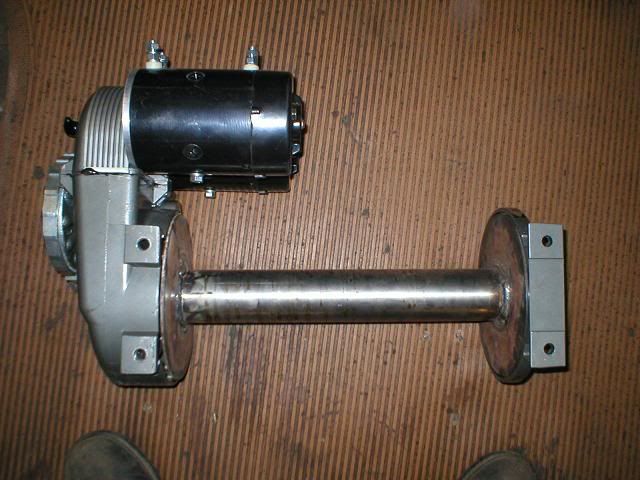
We use Dyneema rope (marine rope) we order by the meter (or foot) and we make our own winch ropes. First because it's way cheaper that way (purchasing at boating stores) and second because we use length and sections that are not readily available from most winch ropes manufacturers like Custom Splice, Master Pull, etc… The bare minimum section we use is 10mm (0.40") for light cars. Our Patrol weighs in the neighborhood of 5000lbs so we use 14mm rope (.55") and I've seen ropes up to 18mm used. Obviously, the thicker the better, stronger and more resistant to abrasion but you store less rope length on your drum the bigger it gets.
You NEED to use a full tubular thimble with your rope as the half tube ones can get crunched and WILL damage your rope in the long run :
Good :

Not Good :

I strongly advice for big hooks too. The stock ones are small AF and you can't use them fast enough or with several shackles inside. Comparison :

Here is how to make your own plasma rope :
Splicing a new plasma winch rope onto your 4x4 off-road winch
The guys at DEVON4x4 are amazing and pioneers of the winching scene over there and I trust their method 100%. I've done a few like that and so far, no problem. Only thing I do differently is I use an electrical terminal as a rope end. I think it's easier to bolt to the winch :

ALWAYS use a tree strap when winching. First you will harm the tree without one but that's not my point. Problem is you WILL hurt the rope buy putting the hook on itself. To go faster than the classic tree strap and shackle, we use a tree strap with a hook at one end and big O-Ring at the other. Makes your life easier and is quick to install and take out. Just like this one :

Second upgrade for the winch is an improved brake :

We use the winches a lot, with repetitive start and stops, thus creating a bunch of efforts on the brake. We also often use the rear winch line as a « life line » in really steep descents and are basically riding the brake all obstacle long. The factory brake holds up to a weekend or two of competition but often lets go after so much abuse and trust me, a fast winch with no brake is scary (at best) and dangerous. That's why we fit upgraded brakes with harder compound and springs. They last much longer and can be rebuilt.
Third upgrade is improved/stronger shafts and gears :

Because of the abuse we throw at them, breakage happens and it's nice to have stronger internals in the winches you beat on all weekend long.
Fourth upgrade is a an air operated freespool.

This a « simple » drum disengagement that's triggered via a solenoid. This way the driver can release the drum from the cab and the co-dog can grab the rope and run with it with basically no drag. It works like that :
Cheviot4x4 8274 Freespool
Last useful mod is more power. It's often done as a third upgrade (dumb move) and leads quickly to stronger gears.
You can get to more power via three different methods :
Bigger motors
More motors
More electrical power
Bigger motors is easy. You basically bolt on a bigger motor. Popular choices are the Warn 6hp motor or one of the Bow motors series (1, 2 or 3, the bigger the more powerful).

More motors can be achieved via two methods. An adaptor plate to bolt two motors in series :

Or via a new top plate specially designed to bolt two motors :

More electrical power is simple and complicated at the same time. What we do is feed 24V in the regular 12V motors. The life expectancy and reliability of those motors is reduced greatly, but the results are mind blowing. Super fast and powerful pulls with no hesitation whatsoever.
Some people are crazy enough to add the twin motor top end + series twin motor adapter for a quad motor winch but this is a very rare mod and they usually break apart really fast.
Obviously the last « weak » part is the main housing itself and they can break under this massive amount of power, that's why they can be upgraded too with thicker wall and even bigger gears :
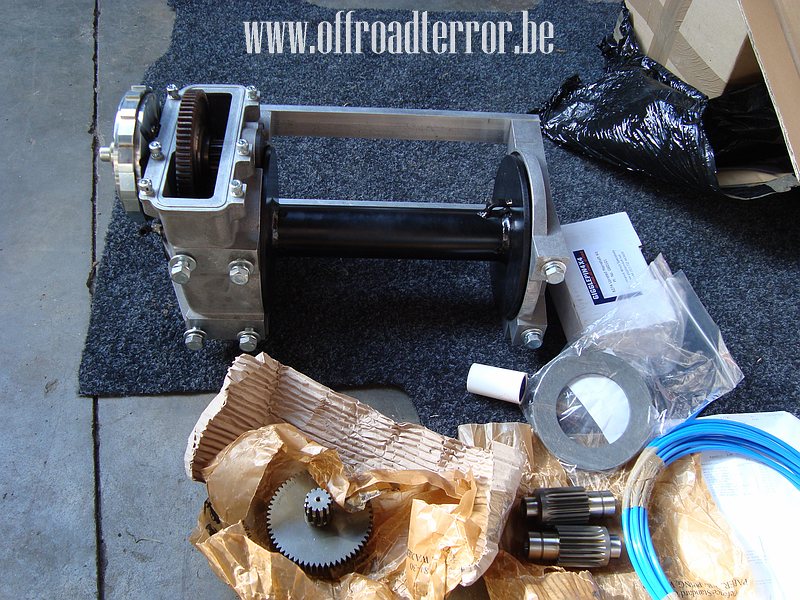
And you end up with something looking approximately like that :

A fully upgraded twin motor 8274 winch like presented can be bought for around 5 grands. And you need 2 of them :smoke:
But keep in mind that breakage = a whole weekend wasted and if you're running for the top spots the whole championship could be wasted on a dumb break like that.
You can also buy purpose build twin motors comp winches. A few companies have perfected the thing and names like Gigglepin, Redwinch, Tibus and MB Corse offer a variety of winches for whatever application you need. They have HUGE behemoths that store 300ft of rope or small nimble high power winches for samurais or UTV's. I can direct you to a few of the companies if you are interested.
I'm a big fan of the Redwinch name tho, the boss is an ultra cool dude and his brand HAS something for your needs. Here is one of the promo vids, just so you actually see what I've been talking about for a long time now :
Red Winch Hornet - High performance electric winch.
I think that's all… Hope you enjoyed the read, don't hesitate for comments and questions, I'd be more than happy to answer to what I can.
Hi guys !
After seing a few of winch recoveries in the US (Pro Rockbouncing event, AOP 4cyl bash, …) and talking with Key at the Hardline Ride, I just wanted to share with you some of the winch tech I know.
I'm not trying to say I know everything about winching (far from it), but what I know might benefit some of you guys in the process of making your recoveries better and safer (main concern here). It's also fun to share info and to see what's happening in other parts of the world and I look forward to hear your feedback.
Being from EU, we have a bunch of competitions that include winching as a part of what you need to do to win. In Winch challenges, the « no ball, hit it with more speed » method doesn't work. The goal is to keep the vehicle intact for a full weekend of competition (including one or two night stages) so we're talking about a total of around 20/25h of driving and every break can DNF you if you're not able to fix your ride with the parts you brought with you and during the time limit. We're obviously trying to be as efficient as possible with winching to keep on driving (cause it's faster…) but you can't avoid it. It also allows to engage in obstacles that are completely unpassable with regular tire traction.
I have been part of a team that used to compete in some french events, just for fun. My job as a co driver was to be the dude that hooks up the winch to whatever is going to be a suitable anchor point to keep our car moving forward or rubber side down. And that's bout it. Some comps hosted in the eastern EU part last for a complete week and the co-dogs have to navigate the car too, but I have no experience in such events. Just a bunch of buddies stories. And they're nasty
This is a video of a winch challenge I competed in. I'm part of the « Team Pirates » and you can see us at 6.45.
challenge xtremland sport 2011 ch2
This is the winching speed that I'm familiar with :
Gigglepin racing at the French Xtrem 2015
Red winch heavy pull.
And unloaded, WATCH YOUR HANDS !
Red Winch Hornet - 24V Supply on 12v Bow2 with Overdrive Gearset
AND USE GLOVES AT ALL TIMES !
First the cars :
In competition winching having two winches on your vehicle is mandatory. The reason is simple, if you have a catastrophic winch failure, you're still able to winch yourself out of the stage, one way or another. The two main winches are generally installed at the front and rear of the vehicle or front and mid-mounted. Some vehicles have three winches, installed like so : front, mid mounted and rear. The mid mounted winch cable exits through the roof with a donut fairlead and is used to stabilize the vehicle in off camber situations, to shift the body weight to help with traction and sometimes, to recover the car from a flop or rollover as help if forbidden in the competition and getting help will DNF you for the stage.
It looks like that :


You generally have 2 classes (varies with sanctioning bodies but that's the common way) which are modified and unlimited.
Modified is :
35" tires or less (measured during tech inspection, what's written on the side of the tire doesn't count)
Mechanical steering (Hydrau assist ok)
Based on a stock vehicle frame (at least 3/4 of the stock frame rails intact)
Unlimited is… well… unlimited.
Depending on the series you can have some that are allowing a full tube chassis in modified class and some that are forbidding rear steer in unlimited.
The good example of a Modified vehicle is the Nissan Patrol I used to co-dog :
Stock drivetrain
RCV shafts
ARB lockers ft/rr
Upgraded winches ft/rr
TSL SX 36"
And this would be an unlimited car (with a good budget) :
LS/TH400/Atlas
Spidertrax axles
Coilovers/Bypasses
40" Treps
Kickass winches ft/rr
Now the interesting part, let's talk about winches :
First, cable is forbidden. I've seen a few close calls with cable breakages and it sucks balls. Whereas a plasma rope breaking just releases tension and falls on the ground. Plus you can fix a plasma rope in the field and continue winching without loosing rope strength if you know how to do the fix (it's not rocket science and I'm going to present that later).
Mechanical winches are not used. They have their place and are widely used in different types of winch challenges (like the asian ones), but for EU terrain and stages (tight around trees etc…), they lack in ease of control and suck balls at braking.
There are very few teams that chose to run hydraulic winches. This is the « theoretical » best solution, but the money involved and the time spent tuning and actually making the system reliable is often prohibitive for most teams.
This explains why 95% of the field is running electric winches and this is going to be the main focus of the post.
If you want to be even remotely competitive, there is only one stock winch that's suitable, the good old Warn 8274. None of the other electric winches are tough enough or can be upgraded as easily to withstand the abuse we throw at them during the comps. Even if the standard version is ok, it is prone to breakage and is often upgraded.
First, you need heavy gauge wire everywhere (needs to be tailored to your winches and installation) and a BIG master switch to cut the power to the winch in case something bad happens. I like to use a couple marine grade HD cutoffs with at least a 500 CONTINUOUS amp rating. Why so big ? Because in case **** hits the fan, a loaded winch is drawing amps like a MOFO and you def. need that bastard to stop without a question. And I'm going to insist here, because I've seen winches with burnt up solenoids go rogue and melt the whole vehicle wiring leading to fire and destruction of said vehicle. Poor dude reached for the kill switch and the thing was already molten and burnt his hand bad. This is a situation no-one wants to see happen. The kill switches need to be placed in a way the driver can reach them, even upside down or in a bad situation. Like on the console. If it's too cluttered or you can't find a suitable spot, I have seen the use of a cable and a T handle to turn them off remotely. Always keep wiring length to a minimum.
As for solenoids, we like the Albright ones a lot. Almost 100% of the competitors run them.

As for batteries we use complete separate systems for the car and the winches. Usually with 2 alternators and 2 or 3 batteries.
One 12V circuit with a standard alternator and a standard battery, like an optima or odyssey
Another 12V or 24V circuit with a BIG alternators (like 250 amps) and a couple batteries in parallel or series depending of voltage.
The grounds don't care if you're on a 24V or 12V circuit and you can ground everything to the chassis normally.
The first upgrade on the winches is a wide drum in order to store more rope. More rope = less change of winch points in the long pulls.

We use Dyneema rope (marine rope) we order by the meter (or foot) and we make our own winch ropes. First because it's way cheaper that way (purchasing at boating stores) and second because we use length and sections that are not readily available from most winch ropes manufacturers like Custom Splice, Master Pull, etc… The bare minimum section we use is 10mm (0.40") for light cars. Our Patrol weighs in the neighborhood of 5000lbs so we use 14mm rope (.55") and I've seen ropes up to 18mm used. Obviously, the thicker the better, stronger and more resistant to abrasion but you store less rope length on your drum the bigger it gets.
You NEED to use a full tubular thimble with your rope as the half tube ones can get crunched and WILL damage your rope in the long run :
Good :

Not Good :

I strongly advice for big hooks too. The stock ones are small AF and you can't use them fast enough or with several shackles inside. Comparison :

Here is how to make your own plasma rope :
Splicing a new plasma winch rope onto your 4x4 off-road winch
The guys at DEVON4x4 are amazing and pioneers of the winching scene over there and I trust their method 100%. I've done a few like that and so far, no problem. Only thing I do differently is I use an electrical terminal as a rope end. I think it's easier to bolt to the winch :

ALWAYS use a tree strap when winching. First you will harm the tree without one but that's not my point. Problem is you WILL hurt the rope buy putting the hook on itself. To go faster than the classic tree strap and shackle, we use a tree strap with a hook at one end and big O-Ring at the other. Makes your life easier and is quick to install and take out. Just like this one :

Second upgrade for the winch is an improved brake :
We use the winches a lot, with repetitive start and stops, thus creating a bunch of efforts on the brake. We also often use the rear winch line as a « life line » in really steep descents and are basically riding the brake all obstacle long. The factory brake holds up to a weekend or two of competition but often lets go after so much abuse and trust me, a fast winch with no brake is scary (at best) and dangerous. That's why we fit upgraded brakes with harder compound and springs. They last much longer and can be rebuilt.
Third upgrade is improved/stronger shafts and gears :

Because of the abuse we throw at them, breakage happens and it's nice to have stronger internals in the winches you beat on all weekend long.
Fourth upgrade is a an air operated freespool.

This a « simple » drum disengagement that's triggered via a solenoid. This way the driver can release the drum from the cab and the co-dog can grab the rope and run with it with basically no drag. It works like that :
Cheviot4x4 8274 Freespool
Last useful mod is more power. It's often done as a third upgrade (dumb move) and leads quickly to stronger gears.
You can get to more power via three different methods :
Bigger motors
More motors
More electrical power
Bigger motors is easy. You basically bolt on a bigger motor. Popular choices are the Warn 6hp motor or one of the Bow motors series (1, 2 or 3, the bigger the more powerful).

More motors can be achieved via two methods. An adaptor plate to bolt two motors in series :

Or via a new top plate specially designed to bolt two motors :

More electrical power is simple and complicated at the same time. What we do is feed 24V in the regular 12V motors. The life expectancy and reliability of those motors is reduced greatly, but the results are mind blowing. Super fast and powerful pulls with no hesitation whatsoever.
Some people are crazy enough to add the twin motor top end + series twin motor adapter for a quad motor winch but this is a very rare mod and they usually break apart really fast.
Obviously the last « weak » part is the main housing itself and they can break under this massive amount of power, that's why they can be upgraded too with thicker wall and even bigger gears :

And you end up with something looking approximately like that :

A fully upgraded twin motor 8274 winch like presented can be bought for around 5 grands. And you need 2 of them :smoke:
But keep in mind that breakage = a whole weekend wasted and if you're running for the top spots the whole championship could be wasted on a dumb break like that.
You can also buy purpose build twin motors comp winches. A few companies have perfected the thing and names like Gigglepin, Redwinch, Tibus and MB Corse offer a variety of winches for whatever application you need. They have HUGE behemoths that store 300ft of rope or small nimble high power winches for samurais or UTV's. I can direct you to a few of the companies if you are interested.
I'm a big fan of the Redwinch name tho, the boss is an ultra cool dude and his brand HAS something for your needs. Here is one of the promo vids, just so you actually see what I've been talking about for a long time now :
Red Winch Hornet - High performance electric winch.
I think that's all… Hope you enjoyed the read, don't hesitate for comments and questions, I'd be more than happy to answer to what I can.




